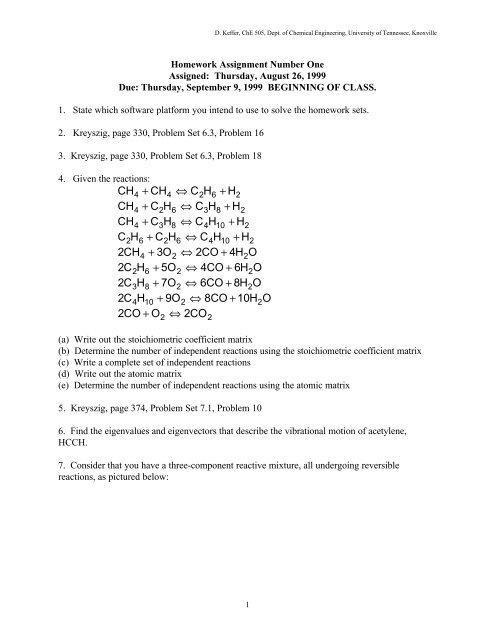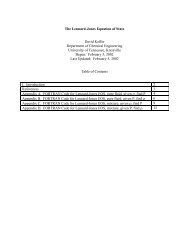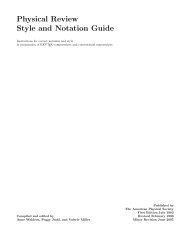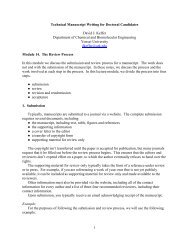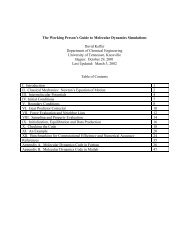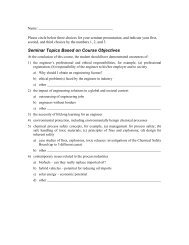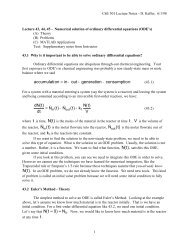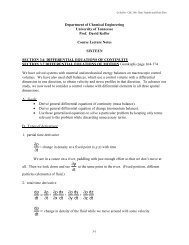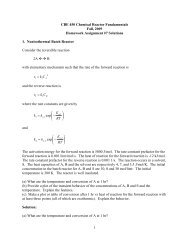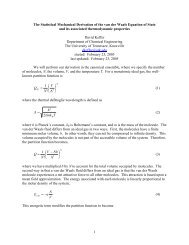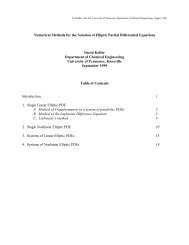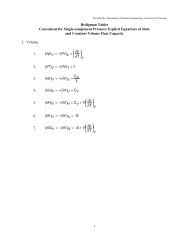Homework Assignment 1
Homework Assignment 1
Homework Assignment 1
Create successful ePaper yourself
Turn your PDF publications into a flip-book with our unique Google optimized e-Paper software.
D. Keffer, ChE 505, Dept. of Chemical Engineering, University of Tennessee, Knoxville<br />
<strong>Homework</strong> <strong>Assignment</strong> Number One<br />
Assigned: Thursday, August 26, 1999<br />
Due: Thursday, September 9, 1999 BEGINNING OF CLASS.<br />
1. State which software platform you intend to use to solve the homework sets.<br />
2. Kreyszig, page 330, Problem Set 6.3, Problem 16<br />
3. Kreyszig, page 330, Problem Set 6.3, Problem 18<br />
4. Given the reactions:<br />
CH 4 + CH4<br />
⇔ C2H6<br />
+ H2<br />
CH 4 + C2H6<br />
⇔ C3H8<br />
+ H2<br />
CH 4 + C3H8<br />
⇔ C4H10<br />
+ H2<br />
C 2H6<br />
+ C2H6<br />
⇔ C4H10<br />
+ H2<br />
2CH4 + 3O2<br />
⇔ 2CO + 4H2O<br />
2C2 H6<br />
+ 5O2<br />
⇔ 4CO + 6H2O<br />
2C3 H8<br />
+ 7O2<br />
⇔ 6CO + 8H2O<br />
2C4 H10<br />
+ 9O2<br />
⇔ 8CO + 10H2O<br />
2CO<br />
+ O2 ⇔ 2CO 2<br />
(a) Write out the stoichiometric coefficient matrix<br />
(b) Determine the number of independent reactions using the stoichiometric coefficient matrix<br />
(c) Write a complete set of independent reactions<br />
(d) Write out the atomic matrix<br />
(e) Determine the number of independent reactions using the atomic matrix<br />
5. Kreyszig, page 374, Problem Set 7.1, Problem 10<br />
6. Find the eigenvalues and eigenvectors that describe the vibrational motion of acetylene,<br />
HCCH.<br />
7. Consider that you have a three-component reactive mixture, all undergoing reversible<br />
reactions, as pictured below:<br />
1
D. Keffer, ChE 505, Dept. of Chemical Engineering, University of Tennessee, Knoxville<br />
A 1<br />
k 12 k 31<br />
k 21<br />
k 13<br />
k 32<br />
k 23<br />
A 2 A 3<br />
In this picture, the A’s are concentrations of the three species and the k’s are rate constants. An<br />
example of this system is the kinetic equilibrium between para-, meta-, and ortho-xylene.<br />
(a) Find the eigenvalues and eigenvectors for the following rate constants in a batch reactor.<br />
k12 = 0.50;<br />
k21 = 0.25;<br />
k13 = 0.20;<br />
k31 = 0.05;<br />
k23 = 0.30;<br />
k32 = 0.15;<br />
(b) Give a physical interpretation of these eigenvalues and eigenvectors.<br />
(c) Find the steady-state composition.<br />
(d) Additionally, allow for flow into and out of the reactor, making it a CSTR. Assume<br />
constant volume in the tank. Derive the model, (write the mass balances). Find the steady-state<br />
composition.<br />
F1_in = 0.1;<br />
F2_in = 0.0;<br />
F3_in = 0.05;<br />
2


